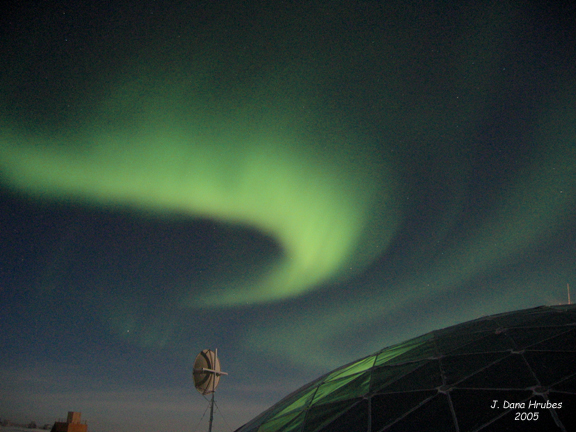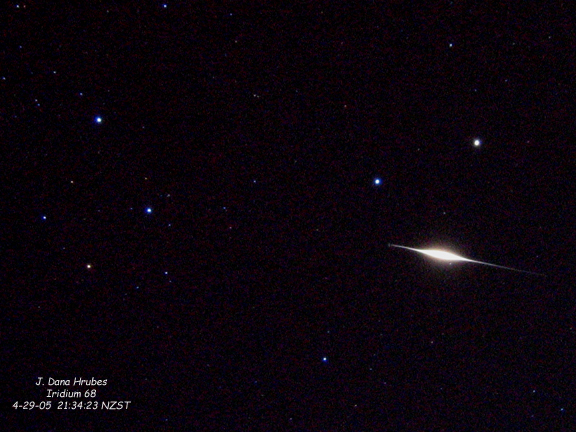
One of the first visible auroras of the winter is seen reflecting its light from the geodesic dome during a full moon.

One
of the first visible auroras of the winter is seen reflecting its light
from the geodesic dome during a full moon.
April at the Pole - darkness,
stars, auroras, satellites
April
is an exciting month as the veil of eternal darkness descends upon us
resulting in beautiful skies full of stars, planets, auroras and
numerous satellites orbiting high enough to reflect the sun to the
polar plateau. The polar twilight is about over now with the sun
nearing 18 degrees below the horizon so we no longer have a hint of the
sun. last
hint of the sun at the geographic pole marker
The moon is visible about 2 weeks out of every month at the
pole. moon
rise moon
over the new station
Winter means not only beautiful skies, but periods of windy weather,
poor visibility, and drifts of snow to shovel at my doors, particularly
the back door of my Cusp Science Laboratory on the first floor of
Skylab, which is now
about 40 feet below the polar plateau. I have some plywood to
deflect some of the drifting snow this year and I am having some
success in reducing my shovel time. skylab door looking out
looking into the
doorway
Even
though we are almost at a minimum of solar activity on the 11 year
solar cycle, aurora activity has been quite good.
aurora over the new station
in moonlight aurora with the moon
twisted aurora
aurora over the dome
aurora over the dome - 2
aurora
over the SETI telescope - 1 aurora
over the SETI telescope - 2 aurora
over the SETI telescope - 3
aurora - 1
aurora - 2
aurora - 3
aurora - 4
aurora - 5
Another
interesting phenomenon here at the South Pole is the ability to view
Iridium
flares about every 9 minutes. Iridium flares are caused by the
satellites that are used for the Iridium communication system. We use iridium
phones
here at the South Pole. There are 66 Iridium
satellites divided into six polar planes (not exactly over the poles,
but close); each plane has 11 operational satellites, so there is at
least one above the horizon everywhere on earth. Since they are
polar orbiters and they all cross near the pole, one satellite of each
of the six orbital planes passes over the pole every
nine minutes and eight seconds. The 11 of each orbital plane are
equally spaced so ~9 minutes, 8 seconds times 11 gives about a 100
minute orbit
around the earth for each. I have taken photos of the same satellite on
successive orbits! Only one of the six planes flares here during a
flare period. When the sun is in the right position, these periods of
flaring at magnitude -8 (very bright) of
one of the six orbital planes can last up to an entire day with a
flare every 9 minutes. Most satellite watchers and photographers are
envious of us at the Pole because the frequency of flaring is reduced
significantly
the further you get from the poles. We have another orbital plane
flaring to
magnitude -8 again on May 10th. There are also a few of these
satellites, as spares, in slightly lower parking orbits, so at rare
times you may see a double iridium flare as I did two weeks ago when I
was walking to the dark sector and fortuitously saw two identical
flares side by side. http://www.iridium.com
iridium flare information
The three flat antennas that face the Earth's surface are like mirrors
and the satellite goes by and then makes a big bright flare as it
reflects the sun, as bright as magnitude -8 or -9, when the conditions
are right. You can see the satellites when they are not flaring of most
of the 6 planes here in their orbits if they are not shadowed by the
earth, but you have to carefully look for them, because they are
normally only about magnitude +6 which is not very bright. At the Pole,
when the conditions are right, each satellite of a particular plane of
11 satellites will flare when it is in the right spot to specularly
reflect sunlight to your observation point or swath. Computer programs
can predict these flares down to the second so I synchronize my watch
to GPS time and push the shutter on my camera about 5 to 7 seconds
before the flare and take a 10 to 15 second exposure.
The satellite flares can be seen almost anywhere on Earth, but much less frequently when away from the geographic poles. find out when iridium flares occur where you live

A Comprehensive
South Pole Web Site by Bill Spindler
Winterover Web Pages
(Bill Spindler's List)